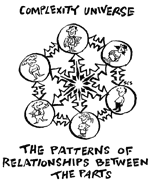
There has been an implicit hierarchy of sciences with physics as the most respectable and
biology as the conceptually poor cousin. Physics is  enviable because of its rigor and immutable laws. Biology on the other hand is rooted in
the messiness of real life and therefore did not create as many elegantly simple
equations, models or predictable solutions to problems. Even within biology there was a
hierarchy of studies. Mapping the genome was more elegant, precise and physics -like,
hence respectable, whereas evolutionary biology was "softer," dealing with
interactions, context and other dimensions which made prediction less precise. Physics
envy was not only evident in the physical and natural sciences but also in the social
sciences. Economics and management theory borrowed concepts from physics and created
organizational structures and forms which tried (at some level at least) to follow the
laws of physics. These were clearly limited in their application and "exceptions to
the rules" had to be made constantly. In spite of the limitations, an implicit
physics envy permeated management and organization theories.
enviable because of its rigor and immutable laws. Biology on the other hand is rooted in
the messiness of real life and therefore did not create as many elegantly simple
equations, models or predictable solutions to problems. Even within biology there was a
hierarchy of studies. Mapping the genome was more elegant, precise and physics -like,
hence respectable, whereas evolutionary biology was "softer," dealing with
interactions, context and other dimensions which made prediction less precise. Physics
envy was not only evident in the physical and natural sciences but also in the social
sciences. Economics and management theory borrowed concepts from physics and created
organizational structures and forms which tried (at some level at least) to follow the
laws of physics. These were clearly limited in their application and "exceptions to
the rules" had to be made constantly. In spite of the limitations, an implicit
physics envy permeated management and organization theories.
Recently, we have seen
physics envy replaced with biology envy. Physicists are looking to biological models for
insight and explanation. Biological metaphors are being used to understand everything from
urban planning, organization design, and technologically advanced computer systems.
Technology is now mimicking life - or biology - in its design. The poor cousin in science
has now become highly respectable and central to many disciplines. Complexity science is a
key area where we witness this bridging of the disciplines with the study of life (or
biology) as the connecting glue or area of common interest.
For health care leaders,
the shift from physics envy to biology envy provides an opportunity to build systems which
are sustainable because of their capacity to "live". Living organizations,
living computer systems, living communities and living health care systems are important
because of our interest in sustainability and adaptability. Where better to learn lessons
about sustainability and adaptability than from life itself.
Next | Previous
| Return to Contents List
All Components of Edgeware Primer Copyright © 2000, Brenda J. Zimmerman.
Schulich School of Business, York University, Toronto, Canada.
Permission to copy for educational purposes only. All other rights reserved.